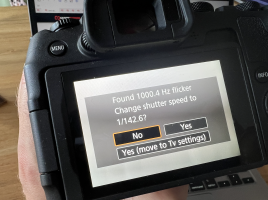Only if that's using lighting that varies exactly with the mains frequency, like incandescent bulbs. This is what Canon wants to solve with 'Anti Flicker'. Fluorescent lights tend to flicker at double the mains frequency.
Yes, LED lighting and LED video walls flicker at a much higher rate, which leads to banding within a single shot. This is what what the 'HF Anti Flicker' feature of my R8 has to say about the light above the dining table:
View attachment 209903
I get the impression that non-PWM dimmers are getting cheaper, I'm seeing that more and more in those affordable super bright flashlights. When I was at TI (a decade ago now), the PWM based devices were starting to offer 1200Hz and faster to get a more even brightness.
Next innovation: no more coil whine on the integrated LED dimmers


